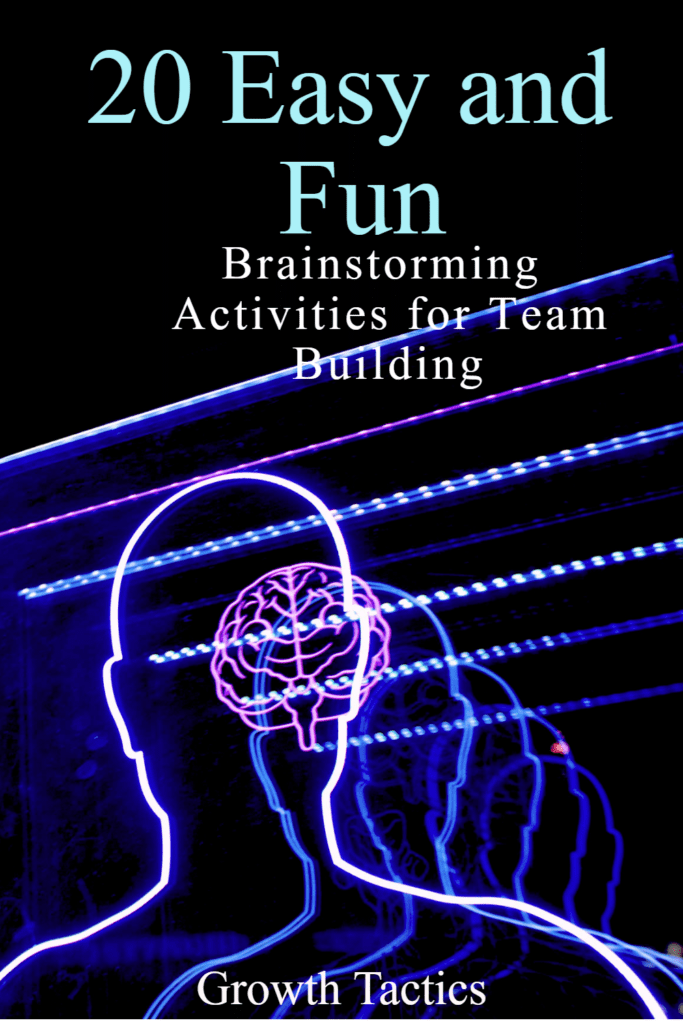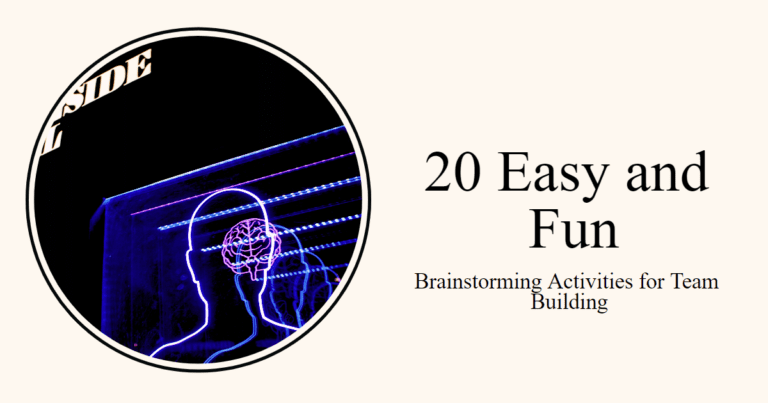Brainstorming is a great way to bring a team together and generate as many ideas as possible. Below are some effective brainstorming techniques to help your team come up with creative ideas and solutions.
Jump To Section
What is the purpose of brainstorming?
Brainstorming is a way to generate creative ideas and solutions to problems. The purpose of brainstorming is to encourage free thinking and open discussion and to generate a large number of ideas quickly. It’s a collaborative process that involves a group of people coming together to share their ideas and build on each other’s thoughts.
The goal of brainstorming is to break down barriers and encourage creativity. By creating a safe and supportive environment, team members can feel comfortable sharing their ideas, no matter how small or seemingly insignificant. This can lead to innovative solutions and new ways of thinking.
Benefits of Group Team Brainstorming
Group team brainstorming offers numerous advantages for organizations and teams. Here are some key benefits:
- Enhanced Creativity: Group brainstorming encourages free thinking and open discussion, leading to more innovative and diverse ideas.
- Increased Idea Generation: Techniques like mind mapping and round-robin brainstorming help teams generate a large number of ideas quickly.
- Improved Problem-Solving: Methods such as reverse brainstorming and SWOT analysis can help identify potential problems and solutions from multiple perspectives.
- Stronger Team Collaboration: Brainstorming activities foster teamwork and help build on each other’s ideas, creating a more cohesive team.
- Better Team Morale: Working together to generate ideas helps team members feel more connected and invested in projects.
- Different Perspectives: Techniques like rolestorming and the Six Thinking Hats method encourage viewing problems from various angles.
- Safe Environment for Sharing: Effective brainstorming creates a supportive atmosphere where team members feel comfortable sharing all ideas, regardless of perceived significance.
- Improved Decision-Making: Activities like dot voting can help teams prioritize ideas and make better-informed decisions.
- Enhanced Communication Skills: Regular brainstorming sessions can improve team members’ ability to express and explain their ideas clearly.
- Increased Engagement: Interactive brainstorming techniques keep team members actively involved and invested in the process.
Brainstorming Activities for Team Building

Mind Mapping
Mind mapping is a visual brainstorming technique that involves writing down a central idea or problem, then drawing branches from it and writing related ideas on each branch. From there, you can draw sub-branches and add more detailed ideas. Mind mapping encourages free association and can help identify connections between different ideas.
Reverse Brainstorming
Reverse brainstorming is a technique that involves brainstorming ways to make a problem worse, rather than ways to solve it. This approach can help identify potential problems and challenges, and can lead to more creative solutions when working backwards to address these issues.
Round-Robin Brainstorming
Round-robin brainstorming involves passing a piece of paper around the group, with each team member adding an idea to the list. This approach encourages team collaboration and helps build on each other’s ideas. Round-robin brainstorming can be useful for generating a large number of ideas quickly.
SWOT Analysis

SWOT analysis is a structured brainstorming technique that involves identifying the strengths, weaknesses, opportunities, and threats associated with a particular idea or project. This approach can help identify potential risks and opportunities, and can be useful for strategic planning and decision-making.
Brainwriting
Brainwriting is a technique that involves each team member writing down their ideas on a piece of paper, then passing the paper to the next person who adds their ideas. This approach encourages team collaboration and helps build on each other’s ideas. Brainwriting can be useful for generating a large number of ideas quickly and anonymously.
Starbursting
Starbursting involves writing down a central idea in the center of a piece of paper, then writing down questions related to the idea around it. This approach can help identify potential problems and opportunities, and can be useful for brainstorming new ideas and solutions.
Worst Possible Idea
The worst possible idea technique involves encouraging team members to come up with the worst possible ideas related to a particular problem or project. This approach can help identify potential risks and challenges, and can lead to more creative solutions when working backwards to address these issues.
Rolestorming
Rolestorming involves each team member taking on a different role and brainstorming ideas from that perspective. This approach can help identify potential solutions from different perspectives, and can be useful for identifying potential problems and solutions.
Storyboarding
Storyboarding involves creating a visual story that outlines the problem and potential solutions. This approach can help identify potential problems and solutions in a more visual way, and can be useful for communicating ideas to others.
Random Word Association
Random word association involves starting with a random word and brainstorming ideas related to that word. This approach can help generate creative ideas and can be useful for thinking outside the box.
SCAMPER
SCAMPER is an acronym that stands for substitute, combine, adapt, modify, put to another use, eliminate, and reverse. This technique involves generating ideas by asking questions related to the problem or project, such as “What can we substitute?” or “What can we combine?” This approach can help identify potential solutions and can be useful for thinking creatively.
The Six Thinking Hats
The six thinking hats technique involves assigning each team member a different “thinking hat” and brainstorming ideas from that perspective. The hats include the white hat (facts and information), the red hat (emotions and feelings), the black hat (risks and challenges), the yellow hat (benefits and opportunities), the green hat (creativity and ideas), and the blue hat (process and organization). This approach can help identify potential solutions from different perspectives and can be useful for decision-making.
The Disney Team Brainstorming Technique
The Disney method involves dividing the team into three groups: dreamers, realists, and critics. Each group brainstorms ideas from their perspective. This approach can help identify potential problems and solutions from different perspectives, and can be useful for developing creative solutions.
The Fishbone Method
The fishbone method involves drawing a fishbone diagram and identifying the problem or project in the center. Then, you can brainstorm potential causes and solutions related to each branch. This approach can help identify potential problems and solutions and can be useful for root cause analysis.
The Lotus Blossom Method
The Lotus Blossom method involves writing down a central idea in the center of a piece of paper, then writing down related ideas in a circle around it. From there, you can draw sub-circles and add more detailed ideas. This approach can help identify potential problems and solutions and can be useful for generating new ideas and solutions.
The Stepladder Method
The Stepladder method involves starting with two team members and having them brainstorm ideas. Then, you can add a new team member and have them add their ideas to the existing list. This approach can help generate a large number of ideas quickly and can be useful for building on each other’s ideas.
The Crawford Slip Method
The Crawford Slip method involves each team member writing down their ideas on a slip of paper and passing it to the next person, who adds their ideas. This approach encourages team collaboration and helps build on each other’s ideas. The Crawford Slip method can be useful for generating a large number of ideas quickly and anonymously.
The SCAMMPERR Method
The SCAMMPERR method is an extension of the SCAMPER method and stands for substitute, combine, adapt, modify, put to another use, eliminate, rearrange, and reverse. This technique involves generating ideas by asking questions related to the problem or project, such as “What can we rearrange?” or “What can we reverse?” This approach can help identify potential solutions and can be useful for thinking creatively.
The Brainstorming Relay
The Brainstorming Relay involves dividing the team into small groups and having them brainstorm ideas in a relay race format. Each team member adds one idea to the list before passing it on to the next team member. This approach can help generate a large number of ideas quickly and can be useful for building on each other’s ideas.
The Dot Voting Method
The Dot Voting method involves each team member being given a set number of dots and placing them next to the ideas they like the most. This approach can help identify the most popular ideas and can be useful for prioritizing ideas and solutions.
Tips for Effective Team Brainstorming

1. Set clear objectives
Before starting the brainstorming session, it’s important to set clear objectives and goals. This will help keep the team focused and on track. Make sure everyone understands what the session is trying to achieve, and what the desired outcome is. This will help ensure that everyone is on the same page and working towards the same goal.
2. Choose the right setting
The setting for the brainstorming session is important. It should be a quiet, comfortable room with enough space for everyone to move around and express their ideas. The setting should be conducive to brainstorming and encourage creativity. It’s also important to ensure that there are no distractions, such as phones or other devices, that could interrupt the session.
3. Encourage participation
Encouraging participation is crucial for effective team brainstorming. Make sure everyone feels comfortable sharing their ideas, no matter how small or silly they may seem. The goal is to generate as many ideas as possible, and every idea counts. Encourage team members to speak up and share their thoughts, and make sure everyone has an opportunity to contribute.
4. Set ground rules
Establishing ground rules is important to ensure that everyone feels comfortable sharing their ideas. Ground rules could include no interrupting, no criticizing, and no judgment. Make sure everyone understands the ground rules and agrees to abide by them. This will help create a safe and supportive environment for brainstorming.
5. Use brainstorming techniques
There are many brainstorming techniques that can be used to encourage creativity and generate a large number of ideas quickly. Some techniques include mind mapping, reverse brainstorming, round-robin brainstorming, and SWOT analysis. Choose the techniques that work best for your team and the goals of the session.
6. Assign roles
Assigning roles to team members can help keep the session organized and on track. For example, one person can be the facilitator, another can be the note-taker, and another can be the timekeeper. This will help ensure that everyone is focused on their role and that the session runs smoothly.
7. Build on each other’s ideas
Encourage team members to build on each other’s ideas. This can lead to more creative solutions and can help the team feel more connected. When someone shares an idea, encourage others to add to it or build on it. This will help generate even more ideas and can lead to innovative solutions.
8. Take breaks
Taking breaks is important to allow team members to recharge and refocus. Brainstorming can be intense and draining, so taking regular breaks can help prevent burnout and keep the team energized. Make sure to schedule breaks throughout the session to allow everyone to take a breather and come back refreshed.
9. Use visual aids
Using visual aids such as whiteboards, sticky notes, and mind maps can help organize and visualize ideas. This can help the team see patterns and connections between ideas, and can make the brainstorming process more engaging. Encourage team members to use visual aids to help bring their ideas to life.
10. Follow up
Following up after the session is important to ensure that everyone is clear on the next steps and to keep the momentum going. Make sure to document the ideas generated during the session and assign action items to team members. This will help ensure that the ideas are put into action and that the session was not just a one-time event.
Wrapping Up Our Brainstorming Games
In conclusion, brainstorming activities are an effective way to boost team creativity, collaboration, and problem-solving skills. By creating a safe and supportive environment, team members can feel comfortable sharing their ideas and building on each other’s thoughts. From mind mapping to reverse brainstorming, there are many techniques that can help generate innovative solutions. So, gather your team and try out some of these brainstorming activities to take your team building efforts to the next level!
Did you enjoy this article on brainstorming activities for team building? Don’t forget to share and subscribe.


